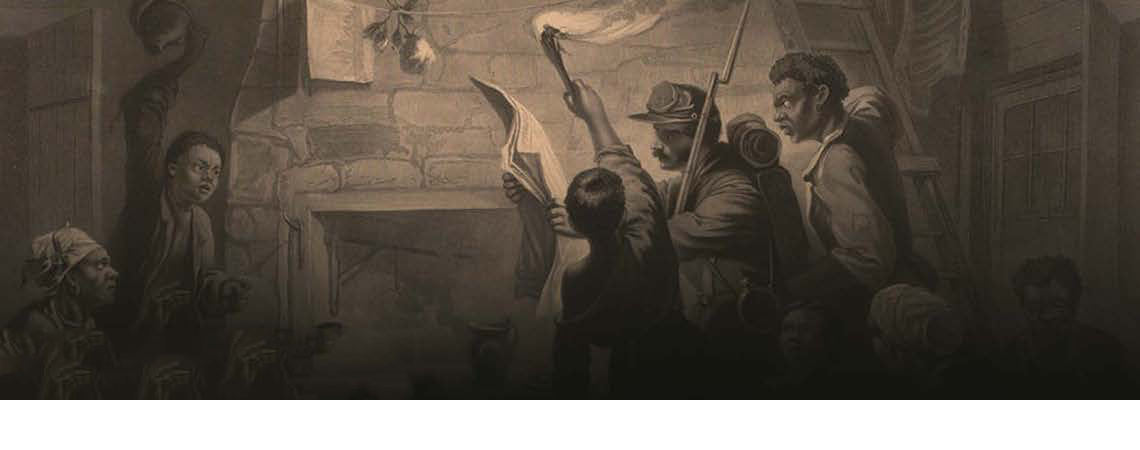Abolition and Antebellum Reform
by Ronald G. Walters
 When the Boston abolitionist Thomas Wentworth Higginson looked back on the years before the Civil War, he wrote, "there prevailed then a phrase, ‘the Sisterhood of Reforms.’" He had in mind "a variety of social and psychological theories of which one was expected to accept all, if any." Of that sisterhood, anti-slavery stands out as the best-remembered and most hotly debated, even though it was not the largest in terms of membership or the most enduring. (That honor goes to the temperance movement.) Abolitionism continues to fascinate because of its place in the sectional conflict leading to the Civil War, its assault on gender and racial inequality, and its foreshadowing of the twentieth-century Civil Rights Movement.
When the Boston abolitionist Thomas Wentworth Higginson looked back on the years before the Civil War, he wrote, "there prevailed then a phrase, ‘the Sisterhood of Reforms.’" He had in mind "a variety of social and psychological theories of which one was expected to accept all, if any." Of that sisterhood, anti-slavery stands out as the best-remembered and most hotly debated, even though it was not the largest in terms of membership or the most enduring. (That honor goes to the temperance movement.) Abolitionism continues to fascinate because of its place in the sectional conflict leading to the Civil War, its assault on gender and racial inequality, and its foreshadowing of the twentieth-century Civil Rights Movement.
Sometimes, however, it is useful to consider abolitionism in relation to Higginson’s Sisterhood of Reforms. The years between 1815—the year that marked the end of the War of 1812—and 1861 did indeed produce a remarkable flowering of movements dedicated to improving society, morals, and individuals. Some appear silly from a present-day perspective (would cheap postage really foster international unity and understanding?), but many contemporaries nonetheless took them seriously. And although Higginson exaggerated connections between movements, it was relatively common for people who believed in anti-slavery reform also to believe in religious reforms, women’s rights, temperance, and health reform. (The latter was based on the idea that proper diet—a severely vegetarian one—could eliminate illness and produce moral human beings.)
Placing anti-slavery within the sisterhood helps us to see both what was and what was not distinctive about it, as well as begin to address the larger question of why certain periods in American history provide especially fertile ground for reform movements. The answer to the latter question is not always straightforward. Drunkenness did not begin around 1819, when a temperance movement began to take shape; slavery had not suddenly changed in 1831, the year a new, more radical anti-slavery movement emerged; and the oppression of women did not start around 1848, the year of the pioneering women’s rights convention in Seneca Falls, New York. For that matter, segregation and racial discrimination began well before the twentieth-century Civil Rights Movement. Making it all the more difficult to answer the question of timing is the fact that periods of intense reform activity sometimes coincide with economic crises, as was notably the case during the Great Depression of the 1930s, while at other times such as the Progressive Era (1890–1919) and the 1960s, periods of reform are also periods of general prosperity. But regardless of whether reform movements take place in good or bad economic times, the point is that reform movements usually are more than just simple, direct responses to a perceived problem.
Multiple changes converged after the War of 1812 to produce the Sisterhood of Reforms. Improvements in transportation—especially steamboats, canals, and railroads—made it easier to send lecturers and publications—including abolitionists, other reformers, and their writings—far and wide. And new printing technologies in the 1830s lowered the cost of publications, including publications from abolitionists.
At the same time, a dynamic American economy created a new class of men and women with the leisure time and financial resources to devote to reform movements. A comparison with eighteenth-century reformers is revealing. They were fewer in number and, with some notable exceptions (mostly Quakers), tended to be part-timers like Benjamin Franklin who were either retired or had other jobs. By contrast, antebellum reformers were both more numerous and, in cases like that of the abolitionist editor William Lloyd Garrison, had no other career.
Social and economic change also provided a psychological context for reform. After 1820, the rapid growth of cities and expanding commerce and manufacturing seemed both to herald a glorious future and to open the door to temptations and vice. How to ensure that God, and not Satan and Mammon, would win?
Behind that question lay two powerful traditions that compelled reformers to contrast what America and Americans were with what they ought to be. One was the legacy of the American Revolution. Even when most critical of their government, reformers evoked it. The first women’s rights convention modeled its declaration after the Declaration of Independence. Similarly, after publicly and notoriously burning a copy of the Constitution on July 4, 1854, William Lloyd Garrison asked, "What is an abolitionist but a sincere believer in the Declaration of ’76?" He was repudiating a government that supported slavery, not the principles of the Revolution.
The other tradition was evangelical Protestantism. An outpouring of religious fervor in the early nineteenth century—sometimes called the Second Great Awakening—swept from west to east and fired the hearts of millions of Americans. It encouraged many to believe they had a moral imperative to do what they could to bring about the Kingdom of God on earth. Although not all evangelicals were reformers, and not all reformers were evangelicals, the Awakening put the power of religion behind a belief that individual men and women could change the world, rather than passively accept as inevitable whatever fate held in store, as their ancestors often had done.
Why should they conclude that that job fell to them rather than to their leaders? The most famous foreign observer of the young republic, Alexis de Tocqueville, was struck by the peculiar propensity of Americans to form local "voluntary associations" to accomplish a wide range of goals, including reforms. In large measure, this was a reasonable approach in a nation with few effective institutional sources of moral authority, and one with relatively weak political institutions, no national church, and a culture mistrustful of governmental power. Use of voluntary associations also reflected a feeling among some—especially the most radical abolitionists—that elected officials were part of the problem, not the solution. Antebellum reformers believed in moral absolutes; politicians believe in the art of the deal, even when the result is compromise with an evil like slavery. Under the circumstances, it seemed better to go around the political system than through it (a position temperance reformers and some abolitionists began to reconsider in the 1840s).
If multiple changes came together after the War of 1812 to produce the Sisterhood of Reforms, they did not determine how antebellum reformers tried to change the world or what they regarded as the main thing wrong with it. Even within a movement like abolitionism, there was widespread disagreement over tactics and goals.
Running through many reforms, however, were common themes and assumptions, one of the most important of which was a passionately held belief that individuals must be able to act as free moral agents, capable of choosing right from wrong, and not restrained by the "arbitrary power" of someone else (like a slaveholder or immoral husband) or something else (like alcohol, bad diet, or mental illness). In that respect, abolitionism was the ultimate expression of the antebellum reform impulse: Slaves, for abolitionists, were the mirror image of freedom, symbols of what it was not—the most extreme example of unfreedom. This logic helps explain the close connection between abolitionists and reforms such as the women’s rights movement, as well as why abolitionists felt an affinity with European revolutionaries and efforts to end serfdom in Russia. All such cases, in their view, were part of a larger international drama of the progress of freedom. With this powerful rhetorical tradition entrenched by the 1840s, it is no accident that the term "slave" persisted in reform rhetoric throughout the nineteenth century, long after the institution itself died in 1865—drunkards as "slaves" to the bottle, women as "slaves" to men, and factory workers as "wage slaves."
Abolitionists themselves were vague about what freedom might mean in practice after the death of slavery, and unconcerned that others might disagree with their definitions. Even so, their emphasis on individual moral agency and their use of the antithesis between slavery and freedom to define freedom’s absence and presence locates them within Higginson’s sisterhood. But in three important respects—in their views on their government, gender, and race—abolitionists parted company with other sisterhood reforms. Few reform movements prior to 1861 produced the fundamental attacks on the American political system that abolitionists mounted in denouncing its devil’s bargain with slavery. And although all major antebellum reforms depended heavily upon women, only a handful of utopian communities gave as prominent a voice to them as abolitionism in its most radical forms.
Most distinctive, however, was how abolitionists framed the relationship between anti-slavery and race, using ideas and concepts that went well beyond the movement’s assault on slavery and that eventually came home in the form of attacks on discriminatory laws and practices in the North. In addition, the abolitionist movement was unusually interracial. The fame of a few black abolitionists—notably Frederick Douglass, Sojourner Truth, and Harriet Tubman—somewhat obscures the high degree to which lesser-known African American abolitionists also supported the cause in every way possible, including with their own organizations, pens, speeches, and dollars. If racism never entirely disappeared among white abolitionists, and if relations between them and black colleagues were sometimes strained, it is nonetheless true that no other movement of the day was remotely close to abolitionism in interracial cooperation, in mobilizing black communities, and in challenging racism in both theory and practice. On those issues, abolitionism was both part of a band of sister reforms and a movement that went well beyond them.
Ronald Walters, Professor of History at The John Hopkins University, is the author of The Antislavery Appeal: American Abolitionism after 1830 (1984) and editor of Primers for Prudery: Sexual Advice to Victorian America (1973) and A Black Woman’s Odyssey through Russia and Jamaica: The Narrative of Nancy Prince (1989).



